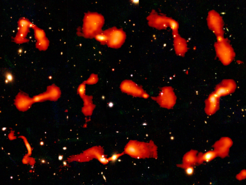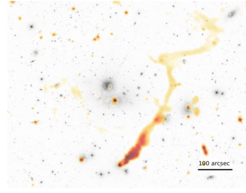Astronomers publish new sky map detecting hundreds of thousands of previously unknown galaxies
An international team of more than 200 astronomers from 18 countries has published the first phase of a major new sky survey at unprecedented sensitivity using the Low Frequency Array (LOFAR) telescope. The survey reveals hundreds of thousands of previously undetected galaxies, shedding new light on many research areas including the physics of black holes and how clusters of galaxies evolve. A special issue of the scientific journal Astronomy & Astrophysics is dedicated to the first twenty-six research papers describing the survey and its first results.

A montage of low-power radio galaxies from the HETDEX region of the LoTSS survey, shown on an optical background.
Radio astronomy reveals processes in the Universe that we cannot see with optical instruments. In this first part of the sky survey, LOFAR observed a quarter of the northern hemisphere at low radio frequencies. At this point, approximately ten percent of that data is now made public. It maps three hundred thousand sources, almost all of which are galaxies in the distant Universe; their radio signals have travelled billions of light years before reaching Earth.
The Low Frequency Array (LOFAR) is a large European network of radio telescopes, with a station at Unterweilenbach operated by the Max Planck Institute for Astrophysics (MPA) and five other stations in Germany. Connected via a high-speed fibre-optic network, powerful supercomputers combine all measurement signals into one single signal, turning the 100,000 individual antennas into a virtual reception dish with almost 2,000 kilometres in diameter.
LOFAR operates in the frequency ranges between about 10 to 80 megahertz (MHz) and 110 to 240 MHz, which have so far been largely unexplored. It is operated by the ASTRON research facility in the Netherlands and is regarded as the world's leading telescope of its kind. Since its official inauguration in 2010, LOFAR has collected a wealth of data and is now presenting its very first sky survey.
"It is amazing how far LOFAR has progressed and what fantastic results it has produced," comments Benedetta Ciardi, who is leading the MPA participation in the LOFAR project. "When we first installed the antennas on our field, we could only dream of such a wealth of results. I am proud that we as a theory institute contribute to this great observational project."
Sky map
In the first section of the sky map, three hundred thousand sources, most of which are galaxies, have been discovered from their faint radio glow. Many of these galaxies were previously unknown: they lie at the furthest most reaches of the Universe and their radio signals have travelled billions of light years to reach Earth.
Black holes
When astronomers observe the sky with a radio telescope, they mainly see emissions from the surroundings of black holes, which are millions of times heavier than the Sun. LOFAR investigates how black holes interact with their host galaxies and in particular studies the “jets” that are visible at radio wavelengths. Due to LOFAR's remarkable sensitivity, the scientific teams have now been able to show that these jets are present in every giant galaxy and that black holes are constantly growing.
Magnetic fields
The radio emission received by LOFAR can also be used to measure cosmic magnetic fields. Researchers from Germany have mapped the magnetic fields in and between galaxies. They were able to show that enormous magnetic structures are located between galaxies. This confirms theoretical assumptions, but could not been proven so far.

Galaxy clusters
The merger of two clusters of galaxies creates gigantic shock waves. "As a student I pointed out that these shock waves should emit radio waves, which would explain the so-called radio relics," remembers Torsten Enßlin, the MPA researcher who was partly involved in the galaxy cluster working group. "With LOFAR data, this hypothesis can be tested in detail - it is exciting!”
The next step
The data now published contain about two percent of the observations planned with LOFAR. The team aims to make sensitive high-resolution images of the whole northern sky, which will reveal 15 million radio sources in total.
LOFAR:
The LOFAR telescope consists of a European network of radio antennas, connected by a high-speed fibre optic network. Together with the Netherlands, Germany in the largest international partner. The six German radio telescope stations are operated by the Ruhr University Bochum, the University of Hamburg, the University of Bielefeld, the Max Planck Institute for Radio Astronomy in Bonn, the Max Planck Institute for Astrophysics in Garching, the Thuringian State Observatory and the Astrophysical Institute Potsdam. LOFAR in Germany is funded by the Max Planck Society, the Federal Ministry of Education and Research, the respective federal states and the European Union.













